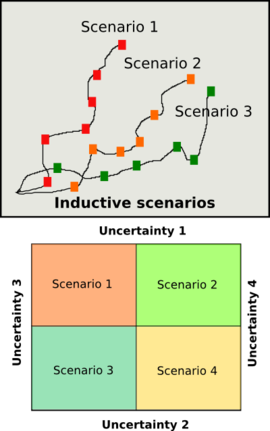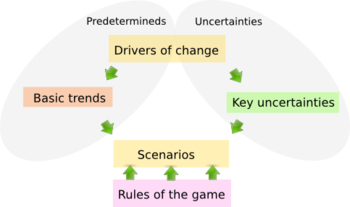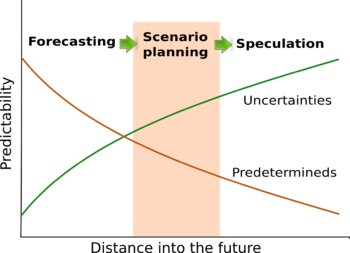Anatomy of a scenario
| Scenario planning for educators | |
|---|---|
| Introduction to scenario planning | Introduction and objectives | Video signpost - Interview with Niki Davis | Definitions | A brief history | e-Learning activity - Discovering scenarios | Anatomy of a scenario | e-Learning activity - Components of a scenario and reflection | FAQs |
Scenarios deal with a complex set of interrelated factors which typically play out over a considerable period of time.
| “ | It’s easy to get lost in the ‘trees’ of these details and lose sight of the ‘forest’ — mastering the dynamic complexity essential to successful strategy. Here’s where the discipline of systems thinking finds its greatest advantage. By using the systems archetypes we can learn how to ‘structure’ the details into a coherent picture of the forces at play. | ” |
| —Peter Senge, 1994[1] | ||
| Microblog activity
Read Peter Senge's quotation above. What do you think? Scenario planning is a creative process of visualising probable futures. Is it appropriate to apply systems thinking to scenario planning? Let us know how you feel by posting on twitter or WEnotes and remember to include the "#SP4Ed" in your post. For example:
Note: If you want to say more than the 140 character limit of a microblog post, feel free to use the open forum or your personal course blog (Remember to label or tag your post with "SP4Ed").
|
Contents
Approaches to scenario planning
There are two broad approaches used for scenario planning:- Inductive scenarios emerge from in depth discussions and detailed explorations and interrogations of the drivers of change and identifiable trends. Inductive scenarios are less structured and rely on group discussions until consensus is reached.
- Deductive scenarios impose a framework for developing the scenario story lines and are usually based on two or more uncertainties to structure the scenario worlds. Deductive scenarios require the prioritisation of the list of factors and assures that individual scenarios are qualitatively different using a logical and non-random structure for the individual scenario story lines.
In this workshop the activities are designed for the development of deductive scenarios which will enable individual participants to generate their own scenarios in the absence of the opportunity for in depth team discussions. Workshop participants who may be working in team setting within their organisations may prefer to use the inductive approach. However, the deductive methodology can also be used effectively in a team setting, particularly where time may be a constraint in holding lengthy discussions needed for the inductive approach.
Components of a deductive scenario
Drivers of change are those factors, which in a given sector push (or pull) organisations away from a “business as usual” state of mind. The change drivers are those factors which could have major impact on the future.
In scenario planning it is important to distinguish between the predetermineds and uncertainties (see for example Schoemaker 1995[2]; Van der Heijgen 1996[3]).Predetermineds refer to those issues, events, factors and trends which are reasonably predictable over the short-term relying largely on a forecasting approach where predictability is based on historical observations and interpretations of the relevant context (see Mercer 1995[4]).
Basic trends are predetermineds which delineate the environmental context within which an organisation operates. They differ from the major drivers of change because they will not likely result in fundamental change in the current business model. Basic trends define the operational context for the scenarios.
Key uncertainties are factors which will have a major impact on the current business model where the outcome is fundamentally unknown. Consequently, in the case of uncertainties, using forecasting approaches for strategic planning would be ineffective because uncertainties do not have a reliable history which could be used to anticipate their future state. Uncertainties can assume states which are significantly different from the present context displaying the characteristics of disruptive technologies, that is a technology that establishes a new value proposition that did not exist before.
It follows, therefore, that drivers of change could be classified as predetermineds or uncertainties, depending on whether the direction or trend of the future outcome is known, or not.
Rules of the game set down the framework within which the scenarios are based. The rules of the game are important for assuring the plausibility and internal consistency of the scenarios.
Basic trends and rules of the game usually remain the same for each scenario, whereas the key uncertainties will be different for individual scenarios.
| Microblog activity
Drawing on your experience, what are the most significant uncertainties in your local context? Think about a driver of change which will have a fundamental impact in your context of which the future outcome is unknown. The purpose of this microblog activity is an initial brainstorm of ideas which we will research and analyse later in the workshop. Share your ideas on the most significant uncertainties by posting on twitter or WEnotes and remember to include the "#SP4Ed" in your post. For example:
|
Relationship between uncertainties and predetermineds over time
Scenario planning is a technique which has evolved from the art of balancing the tensions between identified drivers of change (predetermineds) and factors which are difficult to predict (uncertainties) within volatile markets such as uncertainties associated with disruptive technological change. In these environments, it becomes increasingly difficult to use traditional forecasting techniques, which are largely based on extrapolations from the past. Figure 3 places the predictability of strategic planning interventions into context, illustrating the timing where scenario planning is most effective.Note that the use of forecasting techniques for strategic planning in the shaded area is risky, assuming volatile and fast changing environments. In this shaded area, you will see that conceptually, the "predictability" of the uncertainties exceeds the "predictability" of the predetermineds.
Within the scenario planning range, the likelihood of the future being different from the past is greater than the past repeating itself. Given that its difficult to predict the future, proposing alternative futures enables managers to consider a wide range of decisions should any of these futures materialise.
Notes
- ↑ Senge, P.M. 1994. The fifth discipline. The art and practice of the learning organization. New York: Currency Doubleday.
- ↑ Schoemaker, P.J.H. 1995. Scenario planning: A tool for strategic thinking. Sloan Management Review. 36(2): 25-40.
- ↑ Van der Heijden, K. 1996. Scenarios. The art of strategic conversation. Chichester: Wiley, John & Sons.
- ↑ Mercer, D. 1995. Simpler scenarios. Management Decision. 33(4): 32-41.


